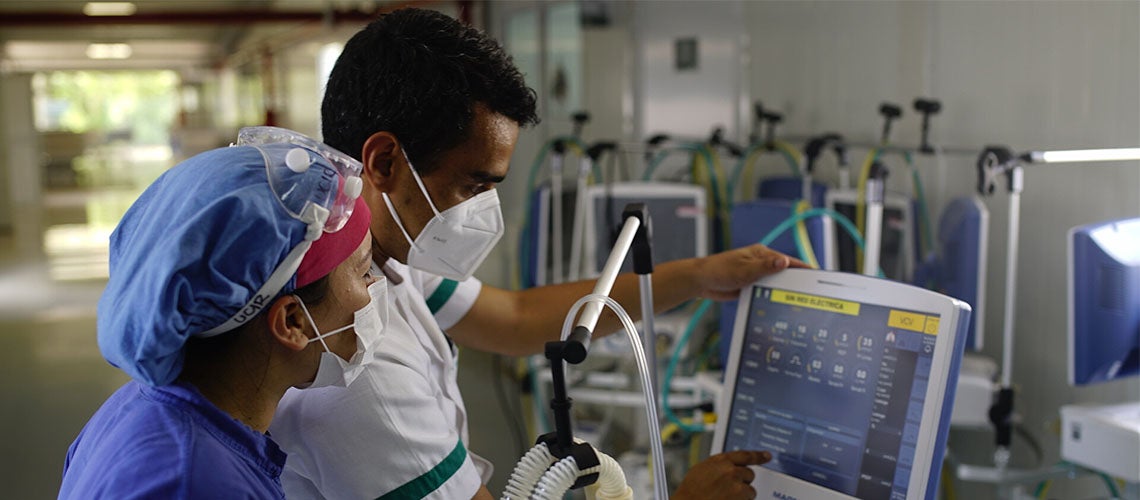 Un enfermero y una enfermera manipulando un equipo médico en hospital de Paraguay
Un enfermero y una enfermera manipulando un equipo médico en hospital de Paraguay
Although Latin America and the Caribbean (LAC) accounts for only 8.5 percent of the world population, by mid-2022 it accounted for 13 percent of global reported COVID-19 infections and 27 percent of deaths. The regional Gross Domestic Product (GDP) contracted 7 percent in 2020 —the largest drop in 100 years and the worst worldwide. School closures left 170 million children out of school losing the equivalent to 1.5 years of learning, erasing a decade of progress in literacy and mathematics achievement.
In this scenario, what should health systems in the region do to recover from pandemic disruptions of essential health services? What investments should governments prioritize to strengthen universal health coverage, health system resilience, and preparedness for future health shocks? A new report from the World Bank addresses these questions and proposes a way forward.
Health systems during the pandemic
Health systems in LAC experienced large and prolonged disruptions in the delivery of essential health services during the pandemic. These disruptions occurred despite improvements in universal health coverage over the last 30 years and reflected long-standing structural handicaps such as underinvestment in human resources and infrastructure, financing and service delivery fragmentation, and poor governance.
Before the pandemic, the region was home to large health inequities and growing mistrust of health systems. As a result of these structural limitations, the pandemic disrupted care for all age groups and disrupted both prevention programs (e.g., immunization, nutrition) and primary and hospital-based care for acute and chronic conditions—disruptions that will increase health inequities and threaten future health outcomes and productivity.
For instance, essential vaccine coverage for children, such as DPT3 vaccination, dropped to 76 percent and 75 percent in 2020 and 2021 from an average of 84 percent for 2017–2019 (percentage of children aged 12-59 months who have received three doses of the Diphtheria–Tetanus–Pertussis vaccine). In Peru, by 2021, healthcare use for acute illness was 14% below pre-pandemic levels for the richest quintile and 32% lower for the poorest quintile. People also became poor or poorer due to out-of-pocket spending: 30 percent of the population in Peru experienced impoverishing medical payments in 2020 (a 45 percent increase over 2019 levels) and levels remained heavily elevated in 2021.
Health progress that must remain in the wake of the pandemic
Despite these disruptions during the pandemic, there were also positive developments that should inspire reforms. For example, health systems have innovated in notable ways such as substantially expanding use of telehealth and telemedicine to improve access to services; increasing the use of data for decision making in real time, and integrating public-private sectors to expand access to care and achieve public health goals during times of crises. Expanding and sustaining these innovations will make health systems more efficient and resilient in the future.
Priorities to build resilient health systems
Investing in health must be a priority for governments. Yet, the region’s public health and health systems remain fragile and inflexible, chronically underfunded, and fragmented. The World Bank report Building Resilient Health Systems in Latin America and the Caribbean: Lessons Learned from the COVID-19 Pandemic offers five priorities for governments to consider as they build resilient health systems, with an emphasis not only on public health emergencies but also on broader health reforms required to strengthen sustainability , quality, and equity of health systems:
- Achieve effective universal health coverage through high-performing primary health care
- Ensure health systems are emergency-ready
- Mobilize adequate financing for health sector resiliency
- Take a life course approach to investments in better human capital outcomes
- Build climate-resilient, climate-smart health systems
This approach is not one-size-fits-all; it can and should be adapted to reflect the tremendous national and sub-national diversity across LAC.
The unprecedented impact of the COVID-19 pandemic in LAC cannot be forgotten and should be examined carefully. There is an imperative to learn from it to inform future reforms and investments to prepare for future public health emergencies, protect lives and the economy, and foster human capital. This will require governments, private sector, and civil society to work together, where international collaboration can be key to accelerate country, regional and global progress.








Join the Conversation